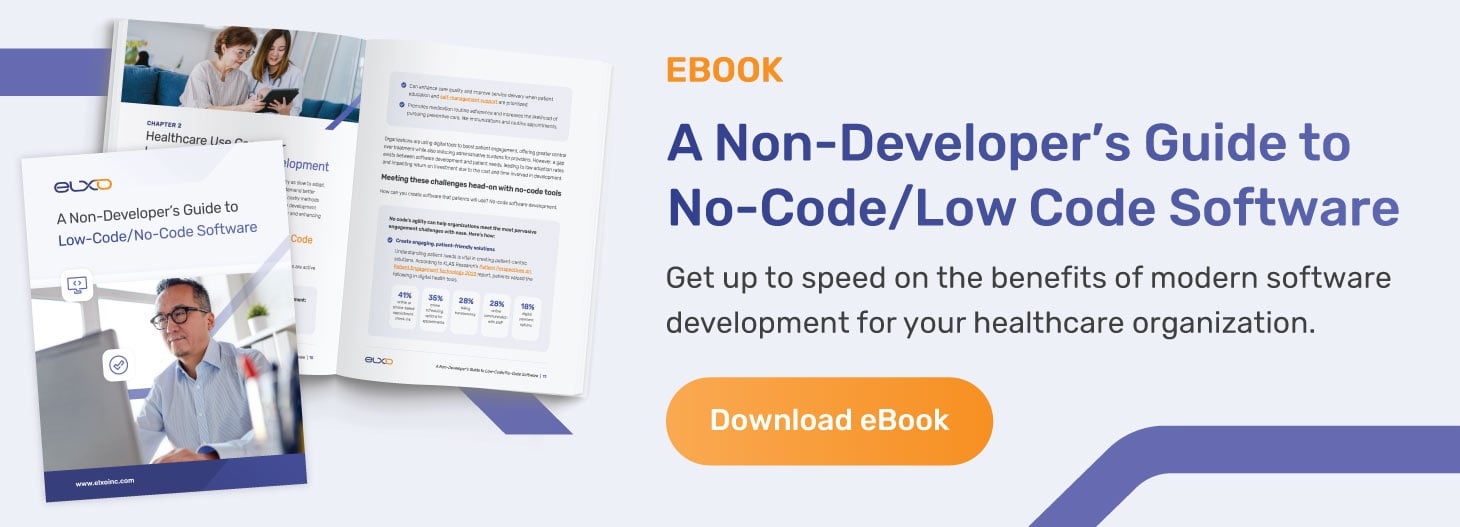To patients, the healthcare industry is often seen as slow to evolve. From archaic infrastructure to lagging digital transformation, there always seems to be some obstacle in the path of a smooth patient experience. This can lead to unnecessary delays, frustrating troubleshooting, and confusion.
Patients are fed up — they want, expect, and demand better tools. But it takes time and money to build new solutions. The dynamic between patient expectations and technical development is difficult to balance, but no code may be the modern, flexible approach healthcare organizations need to engage patients effectively while boosting internal productivity, as well.
Patient engagement in a digital-first healthcare landscape
According to the Centers for Disease Control and Prevention, a growing body of evidence shows that people with higher patient activation — or those who become actively engaged in their healthcare — have better health outcomes.
One such study published in the Journal of Patient Experience shows that:
- Highly engaged patients are more likely to perform health-improving behaviors that correlate with better outcomes and lower long-term costs.
- Engagement in the form of patient education and self-management support can improve the quality of care by better informing patients and enhancing governance and service delivery.
- Engaged patients are more likely to take their medications as prescribed by doctors and pursue preventative care, such as immunizations, regular health checkups, and more.
These are just a few of the many reasons why fostering patient engagement is important for health outcomes, and this, in turn, can build more trust and long-term loyalty between a patient and their healthcare facility.
One of the ways organizations are cultivating higher levels of engagement is through the use of digital tools and technologies, as these solutions can give patients more self-efficacy and control over their treatment while freeing up provider time by automating tedious administrative tasks. However, there’s a disconnect between the development and implementation of digital health tools and the patients they’re created for.
According to a study published in PEC Innovation, there’s a lack of attention to the patient perspective when designing digital health tools, despite their potential to better improve and personalize patient experiences. This can result in low uptake, acceptance, and usage by patients. When you combine low adoption and retention rates with the cost and time of development, it drastically impacts the return on investment of digital tools.
Meeting these challenges head-on with no-code tools
How, then, can you avoid these pitfalls and design solutions that patients will actually use? Healthcare organizations need the means to design patient-centered solutions quickly, simply, and affordably — and that’s where no-code solutions come in.
Traditional software development is too slow, cumbersome, and costly, but the flexibility of no code can help organizations of all sizes meet the most pervasive engagement challenges with ease. Here’s how.
Create engaging, patient-friendly solutions
The key to building patient-centric solutions is understanding what they want. According to KLAS Research’s Patient Perspectives on Patient Engagement Technology 2022 report, surveyed patients valued the following in digital health tools:
- 41% valued appointment check-ins on phone or online
- 35% valued the ability to schedule an appointment online
- 28% valued the ability to know the cost of care
- 28% valued online communication with staff
- 18% valued the ability to make payments digitally
It may feel overwhelming to look at the laundry list of features patients want, especially if you have to build each from scratch. But with no-code platforms, all components are pre-built, pre-configured, and laid out visually. This makes it easy to prioritize features while excluding the extraneous bells and whistles your patients aren’t asking for.
Whether it’s an appointment scheduler, virtual patient check-in, patient onboarding portal, medication tracking tool, telehealth platform, or even an educational content hub, no-code platforms have the features your patients need fully built out. Then, it’s simply a matter of dragging and dropping the components into your core app workflow.
Develop and deploy fast
Technology evolves rapidly – consider how quickly generative artificial intelligence has grown — and people adapt just as fast. With traditional software development, it takes time to build new features and applications. By the time an organization can get them up and running, they may be old news.
No-code tools can help organizations keep pace with the rapid evolution of both technology and patient expectations. Because everything is pre-built and pre-configured, you don’t have to worry about integration delays or lengthy development timelines. This allows you to develop and deploy apps much faster, so you can get the tools patients need into their hands sooner rather than later.
Once your app is launched, you can collect feedback and tweak the workflow in real time. Is one feature underperforming or underused? Remove it or replace it with another and see how that works. This flexibility can show patients that they’re being listened to and getting what they need when they need it.
Continually expand and scale capabilities
After you’ve refined the core experience and patient engagement rates are up, you can test new capabilities to expand the experience. No-code platforms make this simple, too — as new features are built, you can drag them into the workflow and see how patients respond. They may find the new feature solves a problem they didn’t even know they had.
These capabilities can come in many forms, too, from more advanced alert systems to more diverse patient education modules. And as your organization grows, your no-code platform can scale with you, making it easy to adjust workflows and add new users in step with growth.
Low-code tools can take this a step further by enabling you to change the code of no code’s pre-configured modules. If you want a feature to be more robust, low code gives you the opportunity to build on it as desired, opening up new possibilities and the potential to elevate the patient experience to new heights.
Putting the patient at the center of the care journey
As healthcare technology has advanced, workflows for both patients and providers have gotten more complex and fragmented. In some ways, this has been advantageous, like with the invention and mass adoption of telehealth; however, it’s still common for organizations to have too many disparate tools in overly complicated digital environments.
It’s time to pare back that complexity and refocus on what matters most: the patient. No-code tools can help healthcare organizations design workflows that are simple, easy to navigate, and still provide the options and capabilities patients want at scale — without the hassle and costs of traditional development.
If your organization is seeking to not only gain a competitive edge but also embrace a value-based care approach, no code can help you put the patient at the center of everything.
And no matter how complicated the journey, Elxo can ease the path of patient care. Connect with our expert consultants and get started with a no-code demo today.







